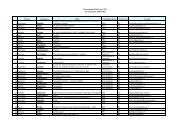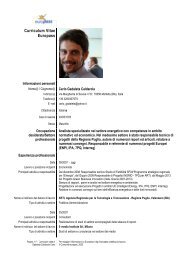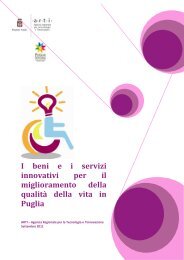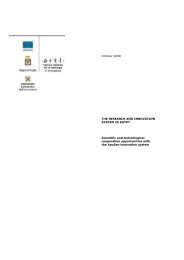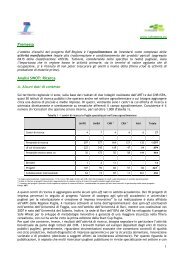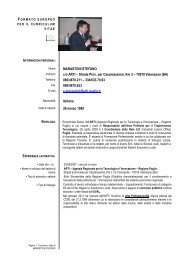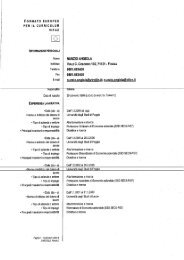the research and innovation system in egypt - ARTI Puglia
the research and innovation system in egypt - ARTI Puglia
the research and innovation system in egypt - ARTI Puglia
You also want an ePaper? Increase the reach of your titles
YUMPU automatically turns print PDFs into web optimized ePapers that Google loves.
skills needed for a successful practical life. Students may attend non-government private<br />
schools, religious schools, or government schools. Primary schools enroll 60 percent of<br />
<strong>the</strong> total school population for all levels of school<strong>in</strong>g <strong>in</strong> Egypt. Approximately 45 percent<br />
of <strong>the</strong> primary students are girls, <strong>and</strong> <strong>the</strong> majority of primary teachers are women. English<br />
<strong>and</strong> French private schools are grow<strong>in</strong>g <strong>in</strong> popularity as bil<strong>in</strong>gualism gives children<br />
social <strong>and</strong> academic privileges <strong>and</strong> later lucrative employment. Primary schools served<br />
7,5 million students <strong>in</strong> 1995-1996. In <strong>the</strong> same year, <strong>the</strong> Al-Azhar Moslem <strong>system</strong> served<br />
704.446 students <strong>in</strong> 1.912 primary schools with ano<strong>the</strong>r 147.762 students enrolled <strong>in</strong> 1.030<br />
preparatory schools.<br />
Preparatory Education: An important function of preparatory education is to provide a<br />
safeguard aga<strong>in</strong>st illiteracy as early school dropouts tend to lapse back <strong>in</strong>to illiteracy. The<br />
enrollments <strong>in</strong> preparatory schools <strong>in</strong> <strong>the</strong> 1990s totaled 3.679.325, less than half that of <strong>the</strong><br />
primary schools. Preparatory schools reflect <strong>the</strong> attrition occurr<strong>in</strong>g <strong>in</strong> <strong>the</strong> f<strong>in</strong>al primary year.<br />
3.3. High School Education<br />
The second tier of compulsory education (grades 7 through 9) lasts for three years.<br />
Students complet<strong>in</strong>g <strong>the</strong> primary part of basic education can complete <strong>the</strong> second part<br />
<strong>in</strong> general preparatory schools, <strong>in</strong> vocational tra<strong>in</strong><strong>in</strong>g centers or schools, or <strong>in</strong> vocational<br />
preparatory classes. Completion of this stage earns <strong>the</strong> Basic Education Completion<br />
Certificate or <strong>the</strong> Certificate <strong>in</strong> Vocational Basic Education. There are two types of public<br />
secondary education: general secondary education <strong>and</strong> technical secondary education.<br />
To enter general secondary education, students must pass a national exam given at <strong>the</strong><br />
end of <strong>the</strong>ir preparatory stage. Secondary schools conduct exam<strong>in</strong>ations every month for<br />
<strong>the</strong> first two years, <strong>and</strong> students take a national exam <strong>in</strong> <strong>the</strong> f<strong>in</strong>al year. Those who pass<br />
receive <strong>the</strong> Certificate of General Secondary Education, a requirement for admission to <strong>the</strong><br />
universities (accompanied by a strong academic record). A wide range of social, cultural,<br />
athletic, scientific, <strong>and</strong> artistic extra-curricular activities are available <strong>in</strong> secondary<br />
schools, usually sponsored by <strong>the</strong> teachers. Enrollment exp<strong>and</strong>ed significantly between<br />
1990-1991 <strong>and</strong> 1994-1995 <strong>in</strong> secondary school (47 percent <strong>in</strong> general secondary <strong>and</strong> 85<br />
percent <strong>in</strong> technical-vocational secondary). In 1994-1995, general secondary enrollment<br />
reached 894.400 students, while technical-vocational enrollment was more than twice as<br />
high at 1.893.800 students. In 1996 secondary school enrollment <strong>in</strong>cluded 68 percent of<br />
<strong>the</strong> appropriate age group (boys, 71 percent; girls, 64 percent). In 1995-1996 <strong>the</strong>re were<br />
2.753 secondary schools with 6.142.651 students <strong>and</strong> 369.107 teachers.<br />
In <strong>the</strong> parallel Islamic educational <strong>system</strong>, known as <strong>the</strong> Al-Azhar <strong>system</strong>, girls <strong>and</strong><br />
boys attend separate schools. In 1995-1996, <strong>the</strong> Al-Azhar Moslem <strong>system</strong> operated 57<br />
secondary schools with 165.829 students. The curriculum is identical to <strong>the</strong> normal<br />
public curriculum with additional study of <strong>the</strong> Quran <strong>and</strong> Islamic sciences. Graduates are<br />
automatically accepted <strong>in</strong>to Al-Azhar University.<br />
Special Education: In <strong>the</strong> year 2000 approximately 10 to 12 percent of pre-university<br />
students were special education students. Responsibility for <strong>the</strong> physically challenged<br />
is shared by <strong>the</strong> M<strong>in</strong>istry of Education (concerned with <strong>the</strong> education of <strong>the</strong> bl<strong>in</strong>d <strong>and</strong><br />
30 <strong>the</strong> <strong>research</strong> <strong>and</strong> <strong><strong>in</strong>novation</strong> <strong>system</strong> <strong>in</strong> Egypt



